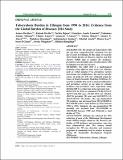| dc.identifier.citation | Deribew, A., Deribe, K., Dejene, T., Tessema, G. A., Melaku, Y. A., Lakew, Y., Amare, A. T., Bekele, T., Abera, S. F., Dessalegn, M., Kumsa, A., Assefa, Y., Kyu, H., Glenn, S. D., Misganaw, A., & Biadgilign, S. (2018). Tuberculosis Burden in Ethiopia from 1990 to 2016: Evidence from the Global Burden of Diseases 2016 Study. Ethiopian journal of health sciences, 28(5), 519–528. https://doi.org/10.4314/ejhs.v28i5.2 | en_US |
| dc.description.abstract | Background: The burden of Tuberculosis (TB) has not been comprehensively evaluated over the last 25 years in Ethiopia. In this study, we used the 2016 Global Burden of Diseases, Injuries and Risk Factors (GBD) data to analyze the incidence, prevalence and mortality rates of tuberculosis (TB) in Ethiopia over the last 26 years.
Methods: The GBD 2016 is a mathematical modeling using different data source for Ethiopia such as verbal autopsy (VA), prevalence surveys and annual case notifications. Age and sex specific causes of death for TB were estimated using the Cause of Death Ensemble Modeling (CODEm). We used the available data such as annual notifications and prevalence surveys as an input to estimate incidence and prevalence rates respectively using DisMod-MR 2.1, a Bayesian meta-regression tool.
Results: In 2016, we estimated 219,186 (95%UI: 182,977-265,292) new, 151,602 (95% UI: 126,054-180,976) prevalent TB cases and 48,910(95% UI: 40,310-58,195) TB deaths. The age-standardized TB incidence rate decreased from 201.6/100,000 to 88.5/100,000 (with a total decline of 56%) between 1990 to 2016. Similarly, the age-standardized TB mortality rate declined from 393.8/100,000 to 100/100,000 between 1990 and 2016(with a total decline of 75%).
Conclusions: Ethiopia has achieved the 50% reduction of most of the Millennium Development Goals (MDGs) targets related to TB. However, the decline of TB incidence and prevalence rates has been comparatively slow. The country should strengthen the TB case detection and treatment programs at community level to achieve its targets during the Sustainable Development Program (SDGs)-era. | en_US |

